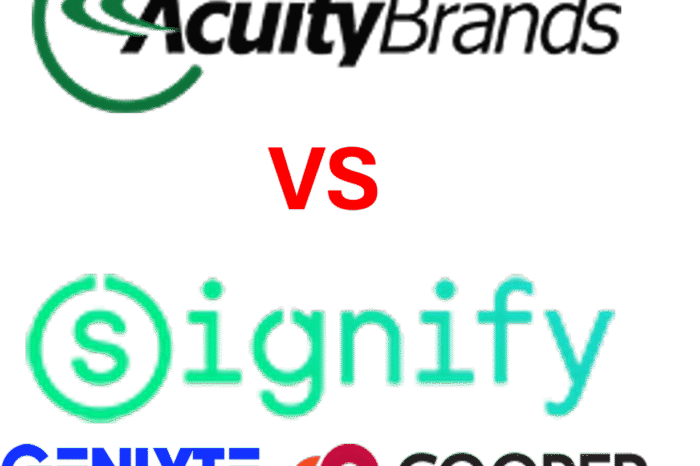Acuity Sales Up But Hints of a Challenging Market
 Acuity’s recent quarter highlights a 6% (gross) sales increase
Acuity’s recent quarter highlights a 6% (gross) sales increase  but, in reading the analyst call transcript and reviewing the results, or what may be called “peeling back the onion”, there appear to be a number of questions.
but, in reading the analyst call transcript and reviewing the results, or what may be called “peeling back the onion”, there appear to be a number of questions.
Analyst Call / Results
- Improved top line growth (in second quarter) but profitability “below expectations”
- Net sales up 3.4% … net sales volume of “over 6%” offset by 3.5% for pricing and product mix”) (continued pricing erosion as well as introduction of new, lower priced, product offering.)
- Interestingly, from a channel perspective, “sales volume was primarily driven by greater shipments of our new Atrius-based luminaries to certain customers in certain key channels” as well as products with popular form factors and for smaller projects (so, questions from an electrical distribution viewpoint are:
- What channel generated the Atrius growth?
- The plural usage of “channels” begs the questions of what are Acuity’s channels to market and how are they really performing in the electrical distribution channel, which is probably their largest or one of their largest? Is the ED channel more than / at / close to the 6% gross or a laggard?
- “Experienced decline in shipments in the non-resi construction market, primarily large projects where demand is soft” (Acuity is built on large projects and there are only X number of them. Our research shows the small to mid-sized markets are having good growth with the large project market slow, nationally. The small / mid-sized area is where Acuity is vulnerable due to lower rep specification involvement, pricing challenges and where Acuity’s brand is less relevant.)
- “and decline in home center channel” (this is due to Home Depot and move to a private label brand)
- Adjusted operating margin down almost 3% (290 basis points)
- “Took actions to enhance overall competitiveness and improve profitability” (sounds like outsourcing and perhaps personnel changes.)
- Experiencing higher freight costs (which we’re hearing from many about)
- See a “weak non-residential construction market”
- Acuity continues to mention “increased competition, primarily for more basic, less-featured products.” (The reality is the competition has been the same for awhile and many of the companies are getting better. Nor do all of them have “lesser-featured” products as they come out with new products regularly and have options for controls, multiple types of lens, configurations, etc. At some point this becomes an excuse as these companies represent a growing reality within the market. When a distributor tells us “I quoted X (leading company), Y (another leading company) but needed to quote Z (a lesser company in the eyes of Acuity, who was already quoted) to earn the business. Contractor bought Z”, this is the market and brand has lost value for small and mid-sized projects. Is Acuity a large project company? Should that be their niche?)
- Relaunching Contractor Select portfolio to target commercial pro and residential consumers! (Think will take share in this segment through competitive pricing and “attributes of differentiation”. Distributors, is this price competitive enough? A viable offering?)
- It’s interesting to hear Acuity think customers will “prefer” their offering and the “affordability” of Juno / Lithonia brands, however, it makes one wonder if there is any brand preference for these lines or in the product category … within distribution at the distributor salesperson level and/or at the contractor level?
- Acuity believes fixture demand declined in North America and that they took share. Feedback from distributors shows differently. Acuity says market is flat to down low single digits vs year ago, (our distributor reported information is up 6% and reps saw their lines are up 7% with price attrition of 4.5%)
- GM% down to 40.2%. (With desired increasing sales of Contractor Select, the margin may remain “steady” as they are probably sourcing much of this, however, gross margin dollars per unit sold will decline … and isn’t it dollars that count?)
- Tier 3 and Tier 4 sales up 20% and is 15% of business (distributors, what % of your business is this? Are you focusing on this area? If so, is it more profitable for you? And if distribution isn’t, how is it being sold (direct?))
- Acuity touts Atrius and mentions retail as a key vertical. (As retail continues to be challenged by Amazon, yes, they need to improve the customer experience and yes there are many buildings that could use Atrius, but, is Acuity growing in a declining market from a long-term perspective? And while Acuity is having some success, what is being done to train distributors to call on local / regional retailers to replicate the model?)
- Board authorized stock repurchase via cash on hand and borrowing (a gesture to maintain stock price which has declined significantly.)
- Want to be positioned as a tech company due to Atrius / Tier 3 and 4. Until this is significantly more, in reality they are a lighting fixture company. Wanting to be and are are two different things.
- The term “current weakness in the lighting market” was used. (The market is “the new market” and there is no “current weakness” as many see the market as robust from an opportunity viewpoint, there is just more manufacturers chasing the business and many are becoming better companies. It’s a more competitive market with sufficient / acceptable product.)
- Outlook – appear favorable, hearing large projects will release, backlogs favorable but Acuity remains cautious and projects “sluggish for the balance of FY 2018. (but lighting is still growing within industry growth expectation range, or slightly ahead)
- Acuity expects to outperform market
- Continue to focus on Tier 3 & 4 with Atrius
- Believe”product substitutions to lower priced alternatives for certain products” will continue and pressure top line growth and profitability (this is a given as it has been occurring and Acuity is late to the game. The question is can this business grow fast enough to retake lost share at distribution and can Acuity fight “hand to hand combat” at the distributor inside salesperson level whereas they are used to focusing on principals and lighting groups / specialists or calling on companies focused on larger projects. Can Acuity influence their reps’ activity?)
- Think that GM% can increase (this only occurs of Tier 3 and Tier 4 grow at a faster rate than Contractor Select … and dollars matter, not %.)
If you’d like to see the quarterly financials, click here.
Here’s some interesting tidbits that were calculated from the data:
- Products
- Tier 3 & 4 – 15% of sales, 23% growth
- Tier 1 & 2 – 52% of sales
- Non-LED – 33% of sales
- Business Type
- Large / Medium Projects – 41% of sales, down 2%
- Small Projects / Stock – 44% of sales, up 1%
- Stock and flow projected at 25% of sales
- Home Center – 12% of sales
So, launching Contractor Select, theoretically, should increase Tier 1 & 2 sales as well as small projects (if large / medium doesn’t grow at an appropriate rate, converted to dollars) to offset.
Analyst Questions / Acuity Comments
- Much talk about Atrius being in high demand (but it’s only 15% of sales and had only 20% growth?)
- Not seeing large project releases (Question to distributors, what percent of these large projects are now having some level of value-engineering done to them to help you win the project? Or another way of thinking about this, what % of specs are hard vs soft?)
- It’s interesting that Acuity refers to others’ products as “lesser featured” but it begs the question of “is that the desired features?” If Acuity offers more, why are those “additional / full” features not desired or valued? Is it a messaging / marketing / value proposition issue? Is it solely a price issue?
- Acuity’s growth reduced due to large project market being soft … on previous calls they mentioned that the small to mid-sized markets were soft and that they didn’t have visibility into those markets and hence stock sales were slow. A change in market or a change in message?
- Jobs $50K+ are important to Acuity, especially if they are Atrius-oriented
- Acuity produces about 80% of its products, source 20%.
Some thoughts:
- Acuity feels the market is flat to low single digits, our Q1 Pulse of Lighting Report with feedback from 150 distributors and 50 in the manufacturer / sales sector shows higher.
- Much commentary on Tier 3 & 4 but little talk of channels to market for it. Also, much resources devoted to an area that represents 15% of sales. Generated a 20% increase, but, through what channel? Is there electrical distribution adoption / support to drive significantly higher results.
- Relaunching Contractor Select but doesn’t think they’ve lost share in this market … very questionable. Distributors will provide some support, sometimes grudgingly, but what will it displace and is it salable. Acuity may need to fight for “shelf space” and share of mind.
- Feel are market leader for large projects but don’t have visibility into timing which is somewhat strange as would think that, especially nowadays, that information could be captured.
- Where does Acuity’s growth come from?
- How can they take share at the lower end?
- How can they accelerate Tier 3 & Tier 4 to represent 33% of the business?
- Competition isn’t going to lessen, so what is their competitive difference to beat each competitor … or do they need to refine the market they pursue? And buying competition won’t make a difference as another company will pop-up.
Seemed to be more focus on the edges of the business and more “guesstimates” to what is happening in the marketplace. Confidence didn’t come through on the call. Where is the growth coming from and where will it come from?
What is the messaging you are hearing?
And from an ED channel perspective, how are they performing for you?
From a lighting agent perspective, how well are they supporting you?























